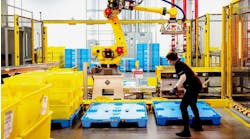By Kevin Finnan, advisor, market intelligence and strategy, Yokogawa
The main issue with predictions about emerging technology is separating futuristic, hypothetical concepts (that might never come to fruition) from those that are now in practice, at least in proof-of-concept form (and will soon produce results).
With that in mind, here are five technologies that in 2023 will take major steps forward from conceptual stages to points where they will prove themselves. The common bottom line is that they all enable sustainable, autonomous industrial operations.
#1: Automatic loop control without PID
PID control (proportional, integral, derivative) is perhaps the most enduring paradigm in the automation world. In his paper, “A Brief History of Automatic Control,” Stewart Bennett of the University of Sheffield, UK observed that “Automatic feedback control systems have been known and used for more than 2000 years.”
While PID will endure for many years to come, there is room for improvement. In particular, engineers continue to grapple with controller tuning.
As companies in the process industries pursue autonomous operations, inhibitors include manual-loop control and even the occasional need for manual intervention when automatic controls encounter problems.
Among the most promising improvements to PID-controller tuning have been applications, which use artificial intelligence (AI) and analytics. Meanwhile, it appears that another, emerging AI application can replace PID altogether. Earlier this year, Yokogawa Electric Corporation and JSR Corporation announced the successful conclusion of a field test in which an AI-based solution autonomously operated a chemical plant for 35 days—a world first. This test confirmed that reinforcement-learning AI could be safely applied in an actual plant; it demonstrated that the technology can control operations that have been beyond the capabilities of PID and advanced-process control (APC).
In a distillation column, the AI solution reacted rapidly to process upsets, stabilized quality, achieved high yield, and conserved energy. Produced products were shipped to customers. The participating companies are firmly convinced of a bright future for AI-based control.
#2: 5G wireless communication in the control loop
The initial reaction among experienced operators and process engineers is likely to be, “Now let me get this straight. You want a wireless, wide-area network in the loop?”
As audacious as that idea might seem, the trend to locate production facilities in remote, hazardous areas in recent years is fueling a growing demand for autonomous operations and transforming how people work. While today’s standard practice is to install a control system or edge devices with control capability physically in the plant, another possible solution is to use much simpler and more reliable edge gateways, which communicate using high-speed, wireless communications with AI-based autonomous control in the cloud.
Yokogawa Electric Corporation and NTT DOCOMO Inc. have recently conducted a proof-of-concept (PoC) test of such a combination. The PoC used an autonomous, AI and cloud-based control solution, developed by Yokogawa and the Nara Institute of Science and Technology, and a 5G mobile-communications network provided by DOCOMO. The test successfully controlled a simulated plant-process operation and demonstrated that 5G is suitable for remote control of actual plant processes.
5G proved to provide the reliability and security to make such remote control feasible. A key characteristic is that it can operate on private networks. The technology is poised to further prove itself, much like the technology for remote work recently did during the COVID-19 pandemic.
#3: AI-enabled mobile robots operate autonomously and collaboratively
The mobile-robotics field is emerging as a key technology for remote, industrial autonomous operations. In hazardous areas or difficult-to-access remote locations, which present many risks to human presence and entail high transportation costs, autonomous mobile robots (including drones) are proving to be very effective.
Mobile robots can simulate operator rounds with many human-like capabilities such as hearing, sight, smell and tactile feel, enabling them to read gauges, record sound signatures, detect hot and cold spots via thermal imaging, and determine valve positions. Robotic-sensor arrays also offer advantages such as wider spectrum ranges than human hearing and sight. Their autonomy and mobility make the robots very cost effective when compared to the vast arrays of fixed-location sensors and video cameras required to provide comparable monitoring.
#4: Open process automation proves itself in the real world
Most process companies are burdened with integrating multiple proprietary systems in almost every process plant and facility. These include manufacturing execution systems, DCSs, PLCs, and their respective human-machine interfaces and inputs/outputs (I/O). The result is elevated capital costs on new projects and a high total cost of ownership. An open-process automation (OPA) system is designed to remedy these challenges by supporting the integration of best-in-class components from different suppliers through configuration and application portability. This enables optimization of the total cost of automation systems.
#5: Carbon-neutral technology turns the corner
With goals set for the year 2050, carbon-neutral technology might seem futuristic—but significant progress is underway now. An inter-industry collaborative study for the achievement of carbon neutrality is in process at an industrial complex in the Goi district of Ichihara City in Japan’s Chiba Prefecture.
The study is examining the feasibility for collaboration by companies in different industries in a carbon-recycling business and involves surveys on the current status of the energy balances of their industrial plants and the capture and reuse of the carbon dioxide (CO2) emitted by them. The goal for this project is to lay the groundwork for a business that will achieve net-zero CO2 emissions for the entire industrial complex by 2050.
Conclusion
An autonomous future will require digital infrastructure that spans an entire enterprise and integrates data, smart devices, and robust hardware and software that deliver the necessary levels of flexibility, adaptability and resilience.
Autonomous operations are considered essential to sustainability because they lead to a symbiosis between industry and society in which those entities function with autonomy, yet in a coordinated manner. Early collaboration, such as the work in process in the Goi district, is necessary for the symbiosis.
The new technologies—mobile robots, artificial intelligence, 5G communications, and open-process automation—enable unprecedented levels of automation, including remote and unmanned operations, which lead to fully autonomous operations. Over the next year, these technologies will take major steps toward enabling autonomous operations and will contribute extensively to sustainability initiatives that include carbon capture and carbon neutrality.



